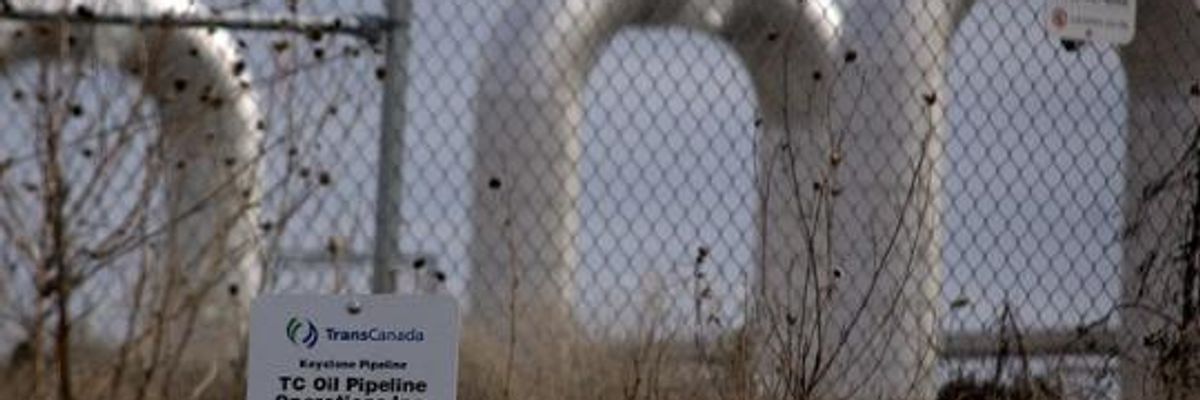

SUBSCRIBE TO OUR FREE NEWSLETTER
Daily news & progressive opinion—funded by the people, not the corporations—delivered straight to your inbox.
5
#000000
#FFFFFF
To donate by check, phone, or other method, see our More Ways to Give page.


Daily news & progressive opinion—funded by the people, not the corporations—delivered straight to your inbox.

Pipeline pump stations such as this Transcanada station in rural Nebraska were deemed any easy target for terrorists. (Photo: Shannon Ramos/ Creative Commons)
Hedge fund billionaire and staunch opponent of Keystone XL Tom Steyer has hired a retired Navy SEAL chief to conduct a "threat assessment" of the proposed northern leg of TransCanada's tar sands pipeline.
Released Wednesday, the report was conducted by Dave Cooper, a former Booz Allen Hamilton consultant and retired Command Master Chief of the Naval Special Warfare Development Group, known to most as the infamous SEAL Team 6 that killed Osama bin Laden. Cooper was officially commissioned by NextGen Climate, the environmental group led by Steyer.
In his assessment, Cooper--who spent nearly 10 years determining similar threats and targets in Iraq and Afghanistan--concludes that the tar sands pipeline would be an easy terror target and that such an attack would "wreak havoc" on the landscape it is set to pass through.
In what Cooper deems "the most likely scenario," a single attack could result in the spill of 1.2 million gallons of "highly toxic" tar sands dilbit. A coordinated attack at multiple locations could trigger the "catastrophic spill" of 7.24 million gallons. And, in the most damaging scenario, a coordinated attack across dozens of miles of pipeline with explosions at several pump stations could result in 60 percent of the oil in those sections to spill.
Using TransCanada's own estimates, Cooper calculated that it would take the pipeline company eleven and a half minutes to stop the flow in the event of such an attack.
According to Climate Progress's reporting on the assessment,
[Cooper] conducted a "red cell scenario" analysis of a domestic pipeline's security vulnerabilities, accessing only the information available to someone with an internet connection and no inside knowledge from TransCanada or government. This involved a site visit to one existing pipeline -- Keystone 1 -- to ascertain how easy it would be for someone to gain access to a completed Keystone XL pipeline. This was done as a "cold shot," meaning a mock penetration of a target with no practice or notification and very little planning. Cooper just went to the small town of Scranton, Nebraska and walked up to the pipeline.
He wrote that he was able to "stand at a Keystone 1 pump station for over 15 minutes snapping photos," and "was not approached, questioned, or ever noticed."
The report recommends that the government conduct a security assessment before permitting the construction of any pipeline. It concludes, "No pipeline, no matter how small, can ever be completely secured," adding, "this is particularly true for a pipeline the size of Keystone XL."
_____________________
Trump and Musk are on an unconstitutional rampage, aiming for virtually every corner of the federal government. These two right-wing billionaires are targeting nurses, scientists, teachers, daycare providers, judges, veterans, air traffic controllers, and nuclear safety inspectors. No one is safe. The food stamps program, Social Security, Medicare, and Medicaid are next. It’s an unprecedented disaster and a five-alarm fire, but there will be a reckoning. The people did not vote for this. The American people do not want this dystopian hellscape that hides behind claims of “efficiency.” Still, in reality, it is all a giveaway to corporate interests and the libertarian dreams of far-right oligarchs like Musk. Common Dreams is playing a vital role by reporting day and night on this orgy of corruption and greed, as well as what everyday people can do to organize and fight back. As a people-powered nonprofit news outlet, we cover issues the corporate media never will, but we can only continue with our readers’ support. |
Hedge fund billionaire and staunch opponent of Keystone XL Tom Steyer has hired a retired Navy SEAL chief to conduct a "threat assessment" of the proposed northern leg of TransCanada's tar sands pipeline.
Released Wednesday, the report was conducted by Dave Cooper, a former Booz Allen Hamilton consultant and retired Command Master Chief of the Naval Special Warfare Development Group, known to most as the infamous SEAL Team 6 that killed Osama bin Laden. Cooper was officially commissioned by NextGen Climate, the environmental group led by Steyer.
In his assessment, Cooper--who spent nearly 10 years determining similar threats and targets in Iraq and Afghanistan--concludes that the tar sands pipeline would be an easy terror target and that such an attack would "wreak havoc" on the landscape it is set to pass through.
In what Cooper deems "the most likely scenario," a single attack could result in the spill of 1.2 million gallons of "highly toxic" tar sands dilbit. A coordinated attack at multiple locations could trigger the "catastrophic spill" of 7.24 million gallons. And, in the most damaging scenario, a coordinated attack across dozens of miles of pipeline with explosions at several pump stations could result in 60 percent of the oil in those sections to spill.
Using TransCanada's own estimates, Cooper calculated that it would take the pipeline company eleven and a half minutes to stop the flow in the event of such an attack.
According to Climate Progress's reporting on the assessment,
[Cooper] conducted a "red cell scenario" analysis of a domestic pipeline's security vulnerabilities, accessing only the information available to someone with an internet connection and no inside knowledge from TransCanada or government. This involved a site visit to one existing pipeline -- Keystone 1 -- to ascertain how easy it would be for someone to gain access to a completed Keystone XL pipeline. This was done as a "cold shot," meaning a mock penetration of a target with no practice or notification and very little planning. Cooper just went to the small town of Scranton, Nebraska and walked up to the pipeline.
He wrote that he was able to "stand at a Keystone 1 pump station for over 15 minutes snapping photos," and "was not approached, questioned, or ever noticed."
The report recommends that the government conduct a security assessment before permitting the construction of any pipeline. It concludes, "No pipeline, no matter how small, can ever be completely secured," adding, "this is particularly true for a pipeline the size of Keystone XL."
_____________________
Hedge fund billionaire and staunch opponent of Keystone XL Tom Steyer has hired a retired Navy SEAL chief to conduct a "threat assessment" of the proposed northern leg of TransCanada's tar sands pipeline.
Released Wednesday, the report was conducted by Dave Cooper, a former Booz Allen Hamilton consultant and retired Command Master Chief of the Naval Special Warfare Development Group, known to most as the infamous SEAL Team 6 that killed Osama bin Laden. Cooper was officially commissioned by NextGen Climate, the environmental group led by Steyer.
In his assessment, Cooper--who spent nearly 10 years determining similar threats and targets in Iraq and Afghanistan--concludes that the tar sands pipeline would be an easy terror target and that such an attack would "wreak havoc" on the landscape it is set to pass through.
In what Cooper deems "the most likely scenario," a single attack could result in the spill of 1.2 million gallons of "highly toxic" tar sands dilbit. A coordinated attack at multiple locations could trigger the "catastrophic spill" of 7.24 million gallons. And, in the most damaging scenario, a coordinated attack across dozens of miles of pipeline with explosions at several pump stations could result in 60 percent of the oil in those sections to spill.
Using TransCanada's own estimates, Cooper calculated that it would take the pipeline company eleven and a half minutes to stop the flow in the event of such an attack.
According to Climate Progress's reporting on the assessment,
[Cooper] conducted a "red cell scenario" analysis of a domestic pipeline's security vulnerabilities, accessing only the information available to someone with an internet connection and no inside knowledge from TransCanada or government. This involved a site visit to one existing pipeline -- Keystone 1 -- to ascertain how easy it would be for someone to gain access to a completed Keystone XL pipeline. This was done as a "cold shot," meaning a mock penetration of a target with no practice or notification and very little planning. Cooper just went to the small town of Scranton, Nebraska and walked up to the pipeline.
He wrote that he was able to "stand at a Keystone 1 pump station for over 15 minutes snapping photos," and "was not approached, questioned, or ever noticed."
The report recommends that the government conduct a security assessment before permitting the construction of any pipeline. It concludes, "No pipeline, no matter how small, can ever be completely secured," adding, "this is particularly true for a pipeline the size of Keystone XL."
_____________________